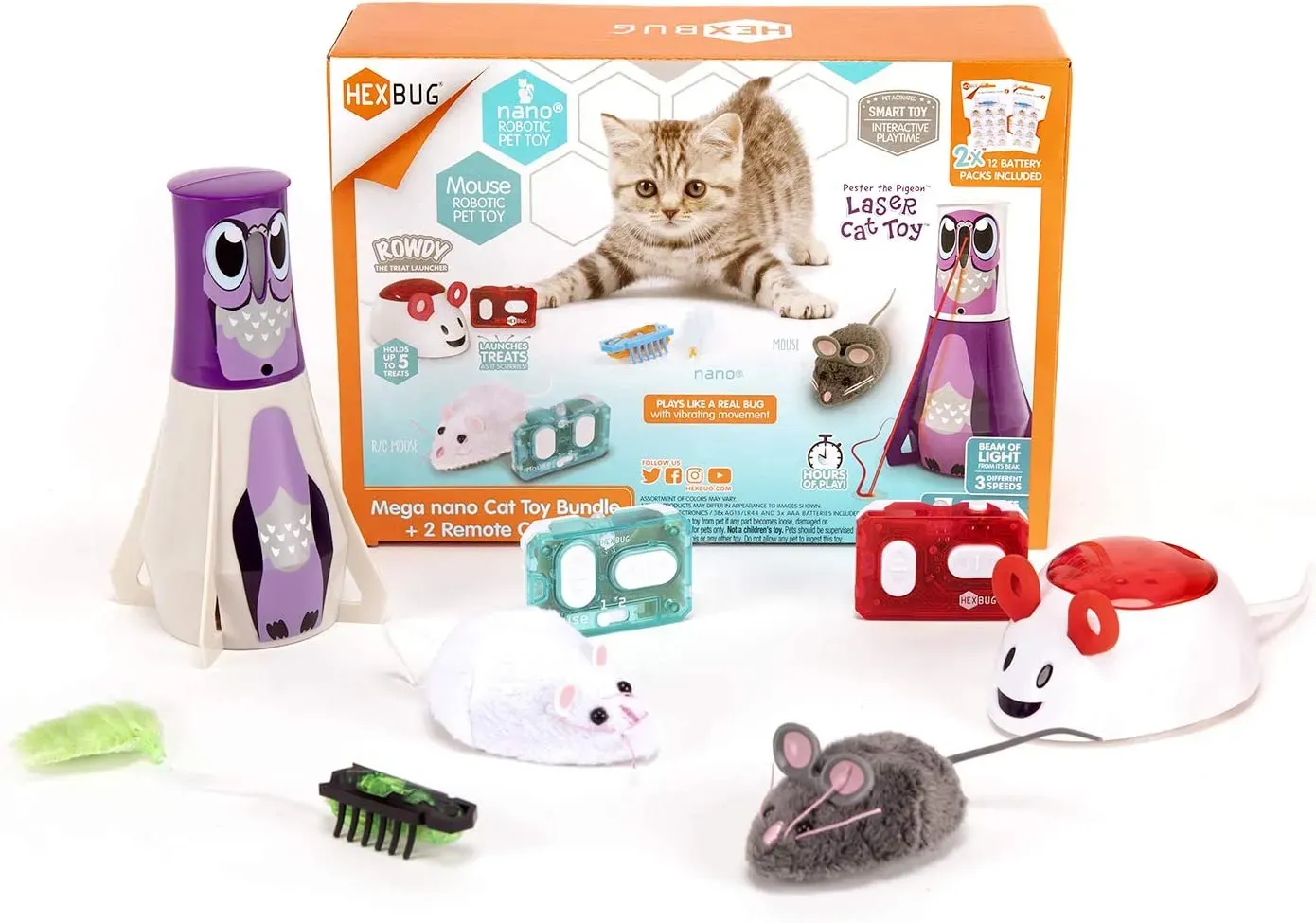Table of Contents
Ah, the joys of working from home. Your commute is non-existent, pants are optional, and your coffee mug is always within reach. But then there's the cat. Specifically, the cat who seems to believe your ankles are chew toys and your keyboard is merely a warm nap spot. You try playing with them, twice a day even, but it's never enough for that relentless ball of fluff and fury. They demand attention, and they demand it *now*, usually right when you're on a crucial video call or finally hitting a productive stride.
Dealing with the AnkleBiter: Why You Need Automatic Cat Toys

Dealing with the AnkleBiter: Why You Need Automatic Cat Toys
The Constant Threat to Your Lower Extremities
Let's be honest. You love your cat. You do. But that doesn't mean you enjoy being stalked through your own home, anticipating the sudden, sharp pain of tiny teeth sinking into your ankle. It's a primal urge for them, sure, but it's also incredibly disruptive when you're trying to, you know, earn a living. Playing with them for 15 minutes in the morning and another 15 in the evening just isn't cutting it for some cats. They have energy reserves that would make a marathon runner weep.
Your furry friend sees your wiggling feet under the desk or your moving legs as prime hunting opportunities. It's not malicious (usually), but it is instinct. And when that instinct kicks in every half hour, your focus evaporates faster than a puddle in the Arizona sun. You need a reliable distraction, something that can absorb that excess energy and redirect those killer instincts towards a less sensitive target than your precious skin.
Automated Peacekeepers for a Productive Day
This is precisely where automatic cat toys earn their keep. They aren't a replacement for dedicated playtime with you, but they are a crucial supplement. Think of them as automated peacekeepers. They provide unpredictable movement, enticing lights, or hidden treats that tap into your cat's natural hunting drive without requiring you to be the direct target. This isn't just about saving your ankles; it's about enriching your cat's environment and giving their busy brains something constructive to do.
A bored cat is often a destructive or annoying cat. By providing an outlet for their energy and predatory behavior through the Dealing with the Ankle-Biter: Why You Need Automatic Cat Toys, you can significantly reduce those unwelcome interruptions. It's an investment in your sanity and your work-from-home productivity.
Common Signs Your Cat Needs More Stimulation (and maybe an auto toy):
- Frequent ankle ambushes
- Attacking your hands or feet during non-play times
- Knocking items off shelves just to watch them fall
- Excessive meowing or demanding behavior
- Chewing on things they shouldn't
- Looking generally bored or restless
Types of Automatic Cat Toys: From Lasers to Robotic Critters

Types of Automatic Cat Toys: From Lasers to Robotic Critters
The Allure of the Elusive Red Dot
Alright, so you're sold on the idea of automated assistance for your feline problem. Great. Now, what kind of mechanical marvel should you introduce to your home? One of the oldest players in the game is the automatic laser pointer. Point it at a wall, turn it on, and watch your cat chase that little red dot with the intensity of a seasoned hunter pursuing a gazelle. They come in various forms: some sit on a flat surface and rotate, others hang from a doorframe and swing, and some even offer multiple patterns or speeds. It's simple, often relatively inexpensive, and taps directly into that chase instinct. Just remember the cardinal rule: always end a laser session by directing the dot onto a physical toy or treat your cat can actually catch, otherwise, it can lead to frustration.
Robots, Springs, and Hidden Whatevers
Beyond the laser, the world of automatic cat toys gets pretty diverse. You've got robotic toys that roll around unpredictably, sometimes with feathers or tails attached to mimic prey. There are towers with balls that spin around tracks, electronic mice that scurry, or toys that hide treats and require your cat to figure out how to get them out. Some toys use motion sensors to activate when your cat approaches, while others run on timers. The variety means you can usually find something to appeal to your cat's specific preferences, whether they're a pouncer, a chaser, or a puzzle-solver. The key is finding a toy that genuinely engages *your* cat, not just the one that looks coolest on the box.
So, which type sounds like it might finally give your ankles a break?
- Automatic Laser Pointers (The classic chase)
- Robotic or Moving Toys (Unpredictable motion)
- Puzzle Feeders (Brain work for treats)
- Electronic Mice or Critters (Mimics small prey)
- Ball Tracks (Simple, contained fun)
Finding the Best Auto Cat Toys: What to Look For

Finding the Best Auto Cat Toys: What to Look For
Beyond the Gimmick: Practical Considerations
so you've seen the dazzling array of options. Lasers zipping, robots rolling, feathers flitting. It's easy to get caught up in the cool factor, but before you click 'buy' on the first shiny object, let's talk practicalities. When you're hunting for the best auto cat toys, think about how it's actually going to function in your home. Battery life is a big one – does it chew through AAAs like they're catnip snacks, or does it have a rechargeable battery that lasts a decent amount of time? Nobody wants to be constantly swapping batteries just to get ten minutes of peace.
Durability is also key. Cats are, by nature, tiny, furry agents of chaos. They will bat, pounce, chew, and generally try to dismantle this new intruder in their territory. Is the toy built to withstand a determined feline assault, or will it be in pieces by lunchtime? Check reviews for mentions of construction quality. And please, for the love of all that is holy, consider safety. No small parts that can break off and be swallowed, no exposed wires, and if it's a laser, make absolutely certain it's a low-power class II laser that won't damage your cat's eyes if accidentally shone directly at them (though you should still avoid doing this).
Matching the Toy to Your Tiny Terrorist's Personality
Just like people, cats have different play preferences. Some are relentless hunters who live for the chase. Others are more like puzzle solvers, intrigued by figuring out how things work or where treats are hidden. Your ankle-biter's specific brand of mischief should inform your choice. Does your cat go nuts for anything that moves fast? A robotic mouse or a high-speed laser might be the ticket. Are they more into stalking and pouncing? Something that pops out unexpectedly could be better. If they're food motivated (and let's be real, most are), a puzzle feeder or a toy that dispenses treats could be a winner.
Also, consider the noise level. Some automatic toys can be surprisingly loud – whirring motors, clacking plastic. If you're on calls all day or have a noise-sensitive cat (or roommate), a quieter option is definitely preferable. Think about ease of use for *you* too. Is it simple to turn on and off? Does it have a timer function so it doesn't run constantly? These little things make a big difference in how often you'll actually use the toy, which in turn dictates how effective it is at saving your ankles.
Key Factors When Choosing Automatic Cat Toys:
- Battery life or rechargeability
- Construction and durability
- Safety features (no small parts, safe laser class)
- Cat's individual play style (chaser, pouncer, puzzle solver)
- Noise level
- Ease of use and timer options
Top Picks: Reviewing Some of the Best Auto Cat Toys

Top Picks: Reviewing Some of the Best Auto Cat Toys
Laser Pointers That Aren't Just Random Dots
Look, we all know the basic automatic laser pointer. It spins, it bounces, your cat goes nuts for a bit, then sometimes gets frustrated because they can't actually *catch* the darn thing. But some newer models are stepping up their game. They offer more unpredictable patterns, change speeds, or even have timed sessions so you don't have to remember to turn them off. We're talking about the ones that make the dot appear and disappear in ways that better mimic actual prey movement, not just a dizzying light show. Think about the ones that bounce off walls at odd angles or pause before zipping off again. These variations keep your cat guessing and engaged for longer periods, which is the whole point of finding the best auto cat toys for a busy household.
Robotic Companions That Roll and Tumble
Then you have the robotic toys that take the concept of 'moving target' quite literally. These are often small, motorized contraptions that roll, wobble, or scoot across the floor. Many have feathers, strings, or other enticing dangly bits attached. The good ones navigate around obstacles (mostly) and offer genuinely unpredictable movements. Some even flip over or change direction when batted, making them more challenging and simulating a struggling critter. My own cat, a ginger menace named Cheddar, spent a solid hour batting a robotic mouse under the couch last week. Peak entertainment, apparently. The better models are sturdy enough to handle repeated pounces and don't get stuck in corners every two seconds.
Which movement style is your cat's weakness?
- Sudden stops and starts (Laser?)
- Wobbling and rolling (Robotic?)
- Peeking out from hiding spots (Pop-up?)
Interactive Puzzle Feeders with a Twist
While maybe not "toys" in the traditional sense, automatic or electronic puzzle feeders are essential for cats who are motivated by food (so, all of them?). These require your cat to manipulate something – batting a lever, pressing a button, or navigating a maze – to get kibble or treats. Some are simple manual designs, but the automated versions might time releases or have electronic elements that add sound or movement to draw your cat in. This taps into their problem-solving skills and hunting drive simultaneously. It turns mealtime into a game, slows down fast eaters, and keeps their brains occupied. It's a different kind of stimulation than chasing a laser, but equally valuable in the quest for the best auto cat toys that provide real enrichment.
Making the Most of Your Automatic Cat Toys & FAQs

Making the Most of Your Automatic Cat Toys & FAQs
Rotate Your Arsenal Like a Pro
So, you've invested in some of the best auto cat toys. You've got the laser, the wobbly robot, maybe even a fancy timed treat dispenser. Great start. But here's the thing: cats, bless their little cotton socks, get bored. Fast. That super exciting new toy they were obsessed with yesterday might be old news by tomorrow. The trick is to treat your automatic toys like a rotating collection at a museum. Don't leave them all out all the time. Introduce one or two for a few days, then put them away and bring out different ones. This keeps the novelty alive and prevents your cat from getting completely jaded. It makes the toy feel "new" again when it reappears, sparking that curiosity and hunting drive.
Timing is Everything (and Supervision Helps)
Just because a toy is automatic doesn't mean you should just turn it on and walk away for eight hours. That's a recipe for a bored cat who figures out how to break it, or worse, gets frustrated. Think about *when* your cat is most active. Is it right before their dinner? Mid-morning zoomies? Schedule the auto-toy sessions during those peak energy times. Many toys have timers, which is super handy. Set it for 15-20 minutes – often, that's enough to wear them out a bit without causing frustration. And while they're playing, keep an eye on them, especially with laser pointers to make sure the beam isn't shining directly into their eyes. It's automated play, not unsupervised free-for-all.
Questions you might be asking yourself:
- How long should I leave the auto toy on?
- Can automatic toys replace playtime with me?
- Why does my cat ignore the new toy?
- Are laser pointers actually bad for cats?
Addressing Those Lingering Questions (FAQs)
Alright, let's hit some common queries. Can automatic toys replace interaction with you? Absolutely not. Think of them as supplements, like a protein shake after a workout, not the entire meal. Your interaction, the one-on-one play, is crucial for bonding and meeting their social needs. Automatic toys just fill in the gaps when you're tied up. Why does your cat ignore a toy? Could be the wrong type for their play style, or maybe you left it out too long and the novelty wore off. Rotate it out and try again later, or try a different type. And the laser pointer debate? As mentioned, frustration can be an issue if they never "catch" the dot. Always end a laser session by directing the beam onto a physical toy or treat they can capture. Use a low-power laser, never directly in their eyes, and supervise. When used correctly alongside other toys, they can be part of a healthy play routine, helping you utilize your best auto cat toys effectively.
Reclaiming Your Ankles (and Sanity)
So, there you have it. The hunt for the best auto cat toys isn't just about spoiling your pet; it's a strategic move in the ongoing battle for your personal space and productivity, especially when working from home. While no toy is a guaranteed magic bullet for every single feline, finding the right automated distraction can significantly reduce those unwelcome ankle ambushes. Consider the types we discussed, weigh the features that matter most for your particular furry menace, and maybe, just maybe, you'll finally get through a conference call without a claw-induced yelp. Good luck out there; your shins are counting on you.